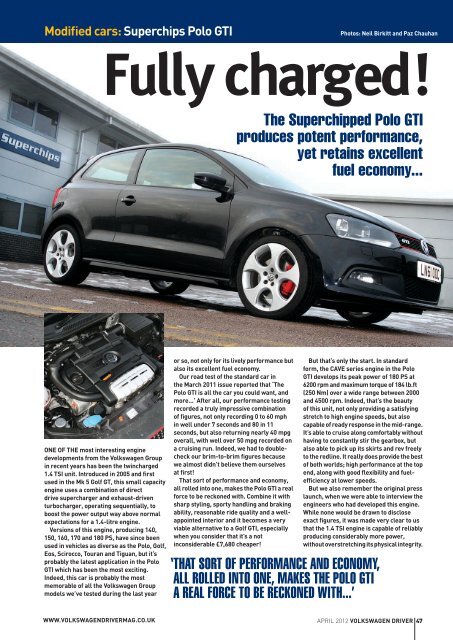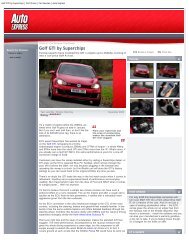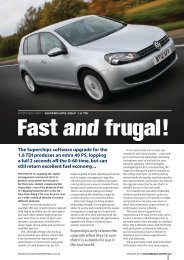Modified cars:Superchips Polo GTI
Modified cars:Superchips Polo GTI
Modified cars:Superchips Polo GTI
You also want an ePaper? Increase the reach of your titles
YUMPU automatically turns print PDFs into web optimized ePapers that Google loves.
<strong>Modified</strong> <strong>cars</strong>: <strong>Superchips</strong> <strong>Polo</strong> <strong>GTI</strong><br />
Fully charged!<br />
ONE Of ThE most interesting engine<br />
developments from the Volkswagen Group<br />
in recent years has been the twincharged<br />
1.4 TSI unit. Introduced in 2005 and first<br />
used in the Mk 5 Golf GT, this small capacity<br />
engine uses a combination of direct<br />
drive supercharger and exhaust-driven<br />
turbocharger, operating sequentially, to<br />
boost the power output way above normal<br />
expectations for a 1.4-litre engine.<br />
Versions of this engine, producing 140,<br />
150, 160, 170 and 180 PS, have since been<br />
used in vehicles as diverse as the <strong>Polo</strong>, Golf,<br />
Eos, Scirocco, Touran and Tiguan, but it’s<br />
probably the latest application in the <strong>Polo</strong><br />
<strong>GTI</strong> which has been the most exciting.<br />
Indeed, this car is probably the most<br />
memorable of all the Volkswagen Group<br />
models we’ve tested during the last year<br />
WWW.VOLKSWAGENDRIVERMAG.CO.UK<br />
or so, not only for its lively performance but<br />
also its excellent fuel economy.<br />
Our road test of the standard car in<br />
the March 2011 issue reported that ‘The<br />
<strong>Polo</strong> <strong>GTI</strong> is all the car you could want, and<br />
more...’ After all, our performance testing<br />
recorded a truly impressive combination<br />
of figures, not only recording 0 to 60 mph<br />
in well under 7 seconds and 80 in 11<br />
seconds, but also returning nearly 40 mpg<br />
overall, with well over 50 mpg recorded on<br />
a cruising run. Indeed, we had to doublecheck<br />
our brim-to-brim figures because<br />
we almost didn’t believe them ourselves<br />
at first!<br />
That sort of performance and economy,<br />
all rolled into one, makes the <strong>Polo</strong> <strong>GTI</strong> a real<br />
force to be reckoned with. Combine it with<br />
sharp styling, sporty handling and braking<br />
ability, reasonable ride quality and a well-<br />
appointed interior and it becomes a very<br />
viable alternative to a Golf <strong>GTI</strong>, especially<br />
when you consider that it’s a not<br />
inconsiderable £7,680 cheaper!<br />
Photos: Neil Birkitt and Paz Chauhan<br />
The Superchipped <strong>Polo</strong> <strong>GTI</strong><br />
produces potent performance,<br />
yet retains excellent<br />
fuel economy...<br />
But that’s only the start. In standard<br />
form, the CAVE series engine in the <strong>Polo</strong><br />
<strong>GTI</strong> develops its peak power of 180 PS at<br />
6200 rpm and maximum torque of 184 lb.ft<br />
(250 Nm) over a wide range between 2000<br />
and 4500 rpm. Indeed, that’s the beauty<br />
of this unit, not only providing a satisfying<br />
stretch to high engine speeds, but also<br />
capable of ready response in the mid-range.<br />
It’s able to cruise along comfortably without<br />
having to constantly stir the gearbox, but<br />
also able to pick up its skirts and rev freely<br />
to the redline. It really does provide the best<br />
of both worlds; high performance at the top<br />
end, along with good flexibility and fuelefficiency<br />
at lower speeds.<br />
But we also remember the original press<br />
launch, when we were able to interview the<br />
engineers who had developed this engine.<br />
While none would be drawn to disclose<br />
exact figures, it was made very clear to us<br />
that the 1.4 TSI engine is capable of reliably<br />
producing considerably more power,<br />
without overstretching its physical integrity.<br />
‘ ThaT sorT of performance and economy,<br />
all rolled inTo one, makes The polo GTi<br />
a real force To be reckoned wiTh...’<br />
APRIL 2012 VOLKSWAGEN DRIVER 47
far from being a weakness, the modest<br />
displacement, with smaller and lighter<br />
reciprocating components, means that the<br />
high-powered 1.4 TSI is less likely to suffer<br />
stress-related failures than larger, heavier<br />
engines with the same power output.<br />
And, of course, any engine with forced<br />
induction, whether it be supercharger or<br />
turbocharger, let alone one with both, can<br />
easily be tuned to higher power outputs<br />
by simply increasing the boost pressures<br />
and manipulating the fuelling and ignition<br />
maps.<br />
It has been over a year since we tested<br />
the standard <strong>Polo</strong> <strong>GTI</strong>, but we recently spent<br />
a few days with an example which has<br />
been modified by <strong>Superchips</strong>. Well known<br />
in the tuning industry, the company has a<br />
long pedigree in electronic engine tuning<br />
which goes back to the Seventies and, while<br />
not specialising exclusively in Volkswagen<br />
Group models, they clearly have a<br />
particular affinity with our own favourite<br />
brands. Regular readers may recall that<br />
we’ve featured quite a number of their<br />
conversions over the years, most recently<br />
reporting on a Mk 6 Golf 1.4 TSI (122 PS),<br />
the same 1.4 TSI engine but turbocharged<br />
only, which had been uprated to 155 PS.<br />
It’s important when evaluating<br />
aftermarket upgrades to consider the<br />
‘ The power and TorQUe<br />
of This 1.4 Tsi are<br />
now on a par wiTh<br />
The 2.8 V6!’<br />
48 VOLKSWAGEN DRIVER APRIL 2012<br />
actual figures measured on the rolling-road<br />
dynamometer. Quite often, it is the case<br />
that the standard car records a baseline<br />
plot which is already well above the factory<br />
quoted figures. It’s all too easy for the tuner<br />
to claim credit for the difference between<br />
the factory figure and the modified amount,<br />
usually also based on a spikey peak figure<br />
rather than a real achievement. <strong>Superchips</strong>,<br />
though, publishes power and torque plots<br />
which clearly show the measured figures for<br />
the standard car and those recorded with the<br />
modifications.<br />
In the case of this <strong>Polo</strong> <strong>GTI</strong>, though, the<br />
standard power plot was right on the button,<br />
with exactly 180 PS recorded at 6447 rpm<br />
and maximum torque of 240 Nm at 2579<br />
rpm. If anything, the torque figure was<br />
slightly down, compared with the factory<br />
figure of 250 Nm, but the graph shows the<br />
same broad range, peaking at 2579 rpm and<br />
remaining high, above 220 Nm, until tailing<br />
off past 5500 rpm. Note that essentially this<br />
same engine is also used in the SEAT Ibiza<br />
Cupra, Skoda fabia vRS and the Audi A1<br />
1.4 TfSI (185 PS).<br />
There are no physical alterations involved,<br />
but <strong>Superchips</strong> modifies the engine<br />
management software by manipulating the<br />
mapping for boost, ignition and fuelling,<br />
to increase power and torque. It’s a field<br />
in which their considerable experience<br />
and expertise stands them in good stead;<br />
knowing just where to readjust the digital<br />
coding to optimise the performance,<br />
without exceeding the safe parameters.<br />
Once all the software development and<br />
testing has taken place, it’s back on to the<br />
in-house Maha rolling-road dyno to power<br />
test the modified mapping and the final<br />
figures show not only a substantial increase<br />
in power, up by 27 PS to 204 PS at 6501<br />
rpm, but also a 35 Nm increase in torque,<br />
peaking at 3475 rpm but also showing well<br />
over 250 Nm all the way from 2500 to 5500<br />
rpm. It’s particularly interesting to note that<br />
the power and torque of this 1.4-litre 4cylinder<br />
engine are now almost identical to<br />
the output of the 2.8-litre VR6 engine which<br />
was used in the Mk 4 Golf V6 4Motion!<br />
Just as important as the actual increase<br />
is that the shape of the curves remains<br />
virtually the same, just moved further<br />
up the scale at the same engine speeds.<br />
It’s exactly what you want to see of a<br />
modified engine, especially one which has<br />
such a perfect blend of power and torque<br />
characteristics on the first place.<br />
It was time to put the <strong>Polo</strong> <strong>GTI</strong> to the test<br />
against the clock, to see just what difference<br />
the improved power output makes to<br />
acceleration and general performance.<br />
WWW.VOLKSWAGENDRIVERMAG.CO.UK
Acceleration figures recorded using VI Monitor.<br />
For more information visit the website at:<br />
www.vi-performance.com<br />
There’s always going to be a problem here,<br />
because any car with only two driven wheels<br />
is going to have difficulty putting its high<br />
power output down cleanly. It can take quite<br />
a few attempts to achieve the optimum<br />
times, even in perfect conditions on a dry<br />
road, and a cold damp day in february was<br />
only going to add to the challenge.<br />
Even in standard form, 180 PS and 250 Nm<br />
is enough to overwhelm the tractive<br />
ability, particularly since the <strong>Polo</strong> <strong>GTI</strong><br />
doesn’t have the XDS (electronic transverse<br />
differential lock) which is used on highpowered<br />
front-wheel-drive stablemates<br />
like the Golf <strong>GTI</strong> / GTD and Scirocco R.<br />
It’s not such a problem in normal everyday<br />
use, because the extra power and torque of<br />
the <strong>Superchips</strong> conversion doesn’t start to<br />
<strong>Superchips</strong><br />
<strong>Polo</strong> <strong>GTI</strong><br />
Standard<br />
<strong>Polo</strong> <strong>GTI</strong><br />
Mk 6 Golf<br />
<strong>GTI</strong> DSG<br />
Mk 5 Golf <strong>GTI</strong><br />
Edition 30 DSG<br />
ABT Sportsline Mk 4 Golf<br />
Scirocco V6 4Motion<br />
2.0 TSI DSG<br />
Displacement, cc 1390 1390 1984 1984 1984 2792<br />
Power output, PS/kW 204/150 180/132 210/155 230/169 240/177 204/150<br />
@ rpm 6500 6200 5300-6200 5500 6000 6200<br />
Maximum torque, lb.ft./Nm 194/263 184/250 206/280 221/300 250/340 200/270<br />
@ rpm 2700-4500 2000-4500 1750-5200 2200-5500 2400-4800 3200<br />
Maximum speed, mph/kph 145/234* 142/229 147/236 151/243 153/246 146/235<br />
0–50 mph, sec 5.0 5.2 4.6 4.8 4.6 5.2<br />
0–60 mph, sec 6.2 6.7 6.5 5.9 5.9 7.0<br />
0–70 mph, sec 7.8 8.8 8.2 7.8 7.3 9.5<br />
0–80 mph, sec 9.8 11.1 10.1 9.8 9.3 11.8<br />
30–50 mph (third gear), sec 2.5 3.2 2.4 2.4 2.3 3.6<br />
30–50 mph (fourth gear), sec – – – – – 4.7<br />
50–70 mph (third gear), sec 2.7 3.5 3.3 3.0 3.0 3.8<br />
50-70 mph (fourth gear) sec – – – – – 4.7<br />
50–70 mph (fifth gear), sec – – – – – 5.9<br />
50–70 mph (sixth gear), sec – – – – – –<br />
Overall fuel consumption, mpg / l/100km 36.7/7.7 38.6/7.3 32.5/8.7 25.8/10.9 34.7/8.1 22.7/12.4<br />
Unladen weight, lb/kg 2797/1269 2797/1269 2952/1339 3086/1399 3122/1416 3089/1401<br />
Power/weight ratio, PS/ton 163/160 144/142 159/157 167/164 172/169 148/145<br />
Test publication date<br />
* Estimated<br />
Apr ’12 Mar ’11 Aug ’09 Mar ’07 Nov ’09 Sep ’00<br />
make itself felt until just after 2250 rpm,<br />
so you can ease it off the line and then apply<br />
the extra power progressively once on the<br />
move. But that’s not a technique which<br />
achieves a significant improvement over<br />
the full-bore 0-60 times we recorded with<br />
the standard car.<br />
Neither is the furious wheelspin and<br />
axle tramp which occurs if you accelerate<br />
forcefully from rest with anything above<br />
2500 rpm on the tacho. Indeed, our first<br />
few acceleration times – recorded on the<br />
VI Monitor which we use for definitive<br />
performance testing – were actually slower<br />
than the standard car. Eventually, though,<br />
after much concerted effort, with ESP off<br />
and feeding in the power progressively, we<br />
managed to extract a set of figures which<br />
showed a significant improvement, with<br />
over half second lopped off the 0-60 time,<br />
a full second off the 0-70 time and nearly<br />
1.3 off the 0-80 time.<br />
Clearly, once the car is up and rolling,<br />
the extra power really tells, and this is<br />
substantiated by the in-gear times, with<br />
nearly a second saved on both the 30-50<br />
and 50-70 times. It might not sound like<br />
much, but when you compare it with the<br />
performance figures for other hot hatches<br />
you realise that the tuned <strong>Polo</strong> <strong>GTI</strong> can<br />
outperform a Mk 6 <strong>GTI</strong> and comes very<br />
close to matching a Mk 5 <strong>GTI</strong> Edition 30.<br />
Note, of course, that we’ve compared with<br />
DSG transmission <strong>cars</strong> in each case, since<br />
the <strong>Polo</strong> <strong>GTI</strong> is equipped with the 7-speed<br />
DSG gearbox as its only option.<br />
WWW.VOLKSWAGENDRIVERMAG.CO.UK<br />
MARCH APRIL 2012 VOLKSWAGEN DRIVER 29 49
Photo: Paz Chauhan<br />
So the outright performance is really<br />
impressive, but what of the general<br />
driveability and fuel economy? Surely, that<br />
will suffer badly as a consequence of the<br />
extra power and performance. Surprisingly<br />
not. In normal low-speed driving and steady<br />
state cruising, the Superchipped car is just<br />
as well mannered as the standard car, and<br />
our careful brim-to-brim checks produced<br />
an overall average figure of 36.7 mpg. Not<br />
quite as good as the 38.6 we achieved with<br />
the standard car, but not by any means<br />
disappointing and probably a consequence<br />
of the extra effort we’d had to employ in<br />
extracting those performance figures.<br />
In normal road use, driven appropriately,<br />
you can even expect to see a small<br />
improvement in mpg since the extra torque<br />
allows you run in a higher gear at any given<br />
road speed. Indeed, on most road trips, at<br />
sensible speeds, we saw the MfA reading<br />
well into the mid-forties, and on a gentle<br />
motorway cruise in the high seventh gear<br />
it registered just over 51 mpg! Even when<br />
you consider the requirement for high<br />
octane fuel (we used BP Ultimate 97 RON),<br />
that still makes it as cost-effective to run<br />
as many lower-powered TDI diesel-engined<br />
models.<br />
Whether the <strong>Superchips</strong> conversion makes<br />
sense in terms of usable performance is<br />
a personal decision. While the extra<br />
power is indisputable, the improvement<br />
in standing-start acceleration times is<br />
academic, because unless you’re going<br />
to spend all day practising on the drag<br />
strip at Santa Pod, or in the Sprint at <strong>GTI</strong><br />
International, you’re not going to reap any<br />
real benefit.<br />
Indeed, indulge in a traffic light grand<br />
prix at your peril, because you’d be just as<br />
likely to be left behind, sitting in a cloud of<br />
your own wheelspin. But for fast mid-range<br />
performance and swift, safe overtaking<br />
ability the <strong>Superchips</strong> <strong>Polo</strong> <strong>GTI</strong> definitely<br />
‘ The real beaUTy of The<br />
TwincharGed 1.4 Tsi<br />
enGine is ThaT iT achieVes<br />
sUch GianT-killinG<br />
performance aT sUch liTTle<br />
cosT in fUel economy...’<br />
gives a good account of itself, in the same<br />
league as Golf <strong>GTI</strong>s costing many thousands<br />
of pounds more. Even in standard form,<br />
the <strong>Polo</strong> <strong>GTI</strong>’s sports suspension and brake<br />
set-up are perfectly adequate to cope with<br />
the improved performance, although it<br />
will undoubtedly benefit from one of the<br />
many upgrades available, perhaps a set of<br />
uprated pads for regular fast-road use or<br />
an adjustable coilover kit to fully exploit the<br />
performance on track days.<br />
The real beauty of the twincharged 1.4<br />
TSI engine, even with the extra performance<br />
afforded by the <strong>Superchips</strong> conversion, is<br />
that it achieves such giant-killing performance<br />
at such little cost in fuel economy, still<br />
capable of overall average mpg figures in<br />
the 40s. That can only be a good thing. III<br />
Other features<br />
<strong>Superchips</strong> Bluefin Mk 5 <strong>GTI</strong> Feb 2007 p23-26<br />
TSI engine in detail Apr 2007 p37-40<br />
<strong>Superchips</strong> <strong>GTI</strong> Edition 30 Jun 2007 p11-14<br />
<strong>Superchips</strong> Bluefin Mk 6 <strong>GTI</strong> Feb 2010 p29-31<br />
<strong>Superchips</strong> Bluefin<br />
Passat CC 2.0 TDI Mar 2010 p32-34<br />
ABT Sportsline Golf 1.4 TSI (210 PS)<br />
May 2010 p24-37<br />
Road test: <strong>Polo</strong> <strong>GTI</strong> Mar 2011 p35-38<br />
<strong>Superchips</strong> Bluefin<br />
Mk 6 Golf 1.4 TSI Apr 2011 p35-38<br />
DIY download by Bluefin<br />
ThE SUPErchIPS re-map on this <strong>Polo</strong> <strong>GTI</strong><br />
was applied using the Bluefin system, using<br />
a handheld module which is plugged into<br />
the standard diagnostic (OBD) port to enable<br />
the EcU mapping to be switched between<br />
standard and high-performance versions.<br />
When the customer first purchases the<br />
Bluefin system, they first plug it into the car,<br />
so that it reads and copies off the actual<br />
original standard EcU mapping in the car.<br />
This is then transmitted to <strong>Superchips</strong> hQ by<br />
internet and checked before the appropriate<br />
new high-performance mapping is sent back<br />
to be loaded into the Bluefin module.<br />
The customer can then subsequently<br />
decide whether to run the car as standard<br />
or load up the high-performance map<br />
themselves, a process which takes about<br />
20 minutes, either way, to make the data<br />
transfer, plugging it in to the OBD port under<br />
the dash and following the simple menu<br />
instructions which appear in the digital<br />
screen. The only real question is whether<br />
you’ll ever want to revert to the standard<br />
software, once you’ve sampled the superior<br />
performance and excellent economy of the<br />
upgrade.<br />
Contact<br />
<strong>Superchips</strong> Ltd<br />
Buckingham Industrial Park,<br />
Buckingham MK18 1XJ<br />
Tel: 01280 816 781<br />
www.superchips.co.uk<br />
50 VOLKSWAGEN DRIVER APRIL 2012 WWW.VOLKSWAGENDRIVERMAG.CO.UK




